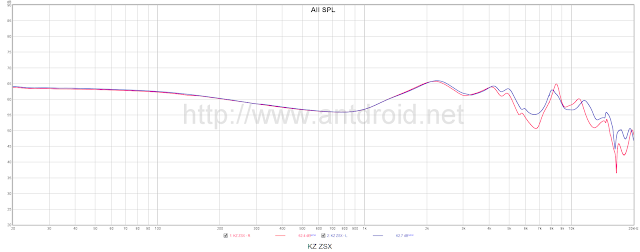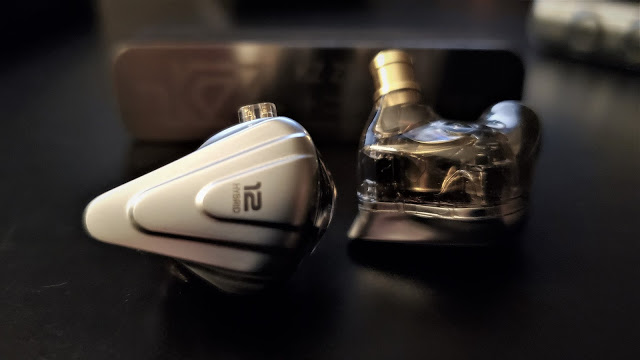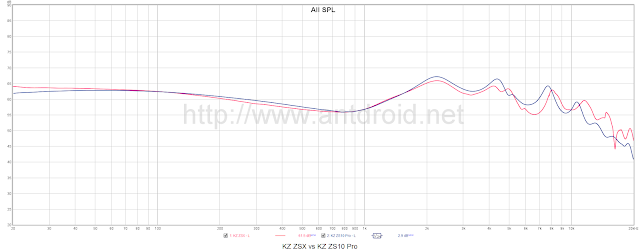I have just finished the review for the ZS10 Pro and uploaded it to my blog in Spanish and English.
Based on what I have read about this elsewhere, I think I may be the odd one out here but I can only really be honest to what I feel I am hearing.
I have re-read the review and some of it probably doesn’t make much sense but I am still going to post as is because this is what I felt at the time of listening and writing. Please forgive any random rambling!
So, if anyone is interested in the ZS10 Pro, I suggest you read other peoples reviews to get a better idea as to what the majority feel about this IEM.
Anywhoo…
KZ ZS10 Pro Review
While I have various IEMs that are awaiting reviews, I thought I would do the ZS10 Pro as they are still relatively new (for KZ I mean) and to be honest, they are the most detailed and clean <50€ IEMs I have tried to date and are certainly worth considering when making comparisons to other IEMs.
As always, I’ll get to the sound in a minute but let’s go through the usual steps so I don’t forget anything!
Disclaimers and info
I purchased these IEMs with my own money, direct from China, so there is no influence in regards to my review. I did (and still do) read a lot of hype about the ZS10 Pro which could maybe play a part in whether or not these meet my expectations but, as always, I will try to be honest to what I hear. I have also ignored graphs posted by others to avoid having too much of a predefined expectation.
Unboxing and first impressions
The ZS10 Pro arrived in a box that is basically identical to the one that the ZSN arrived in. They are presented in the packaging the same way and include the same accessories and cable. In fact, if it wasn’t for the fact that it says ZS10 Pro on the box and that the IEMs are blue and shiny silver, it would be almost impossible to tell them apart at a simple glance.
Again, as with the ZSN, the first impression is of a well built item, showing a quality that is above what I have become to expect in this price range (although KZ is changing my expectations in this regard).
I am not a fan of the shiny plates that are on the exterior, in fact, that was one of the reasons that stopped me from buying the Kanas Pro for so long, I just don’t like the “shinyness”. However, recently KZ has released another version with a blue plate which may be more suitable for those who don’t like shiny things in their ears (like me).
Build quality
As said above, as is with the ZSN, the sensation of a quility build continues when using the ZS10 Pro. The cable is the typical bronze coloured cable that KZ are including lately, and while it does get tangled pretty easily, it does its job and is fine for the purpose.
The ZS10 Pro also uses the same connector as the ZSN (Para C) which has the pins slightly recessed and creates a sensation of being more robust than older versions.
There are no sharp edges to be found and in general it is a well built IEM, or at least that is the impression I get.
Comfort
AS the ZS10 Pro is the same shape and size as the ZSN, the comfort is the same. I find the IEMs comfortable and they are a good fit, however, they are not so comfortable that they just “disappear” and I forget that I am wearing them.
I find that swapping the stock cable for a NiceHCK cable (balanced in my case) helps a little over long periods as the over ear hook is covered in a much softer silicone and is not as rigid.
Power requirements
I find that the ZS10 Pro work fine from my phone, although I do notice an improvement when running them from a more powerful source such as the M2X or the Atom.
I would say that an amplifier is not needed for these IEMs but I do think it gives them a little more freedom (if that makes any sense).
General listening
I have listened to these sporadically since I got them about a month ago but for the last 10 days or so they have been used for various hours a day, mainly running from the M2X.
My first impression of sound when I put them on was “wow, these are clean!” and as time has passed (I probably have 100 hours on them now) I still feel that these are very clean and have much more detail than any other IEM I currently own.
But… and I am not quite sure where this but comes from… I don’t find that I enjoy them for long listening periods.
Whilst I love the detail and how clean the ZS10 Pro sounds, I find that after a while I start to become fatigued while wearing them. In part this is due to the comfort (after 2 or 3 hours I start to get irritated) but at the same time it is due to the sound signature of these IEMs.
They don’t seem to be overly boosted in any frequency (I guess we’ll find out in the measurements) but there is something that just makes me feel that they are harsh. I am not sure why I feel this way with the ZS10 Pro when headphones like the DT1990 (which is very detailed and can be harsh) don’t make me feel this way.
This feeling of harshness is especially present to my ears when listening to tracks that have a lot of instruments, especially acoustic instruments, as sometimes it just feels like the track I am listening to is unfinished, it reminds me of when I am producing music and the song is finished but in need of a final eq and polish. I thought this was probably due to the quality of the tracks I have been listening to but I have tried the same tracks through other headphones, IEMs and studio monitors, none of them seem to exhibit the harshness as much as the KZ ZS10 Pro. Having said this, I want to make it clear that I don’t feel that these sound bad, I just don’t think that they are always a true representation of what the actual overall sound of the track is.
On the other side of the coin, this extreme detail is great for monitoring or even mixing to some extent. I have found these to be a good option for monitoring when playing bass and being able to clearly define what is going on around me. I will try and do a comparison at some point between the IEMs I have and how they stand up to a live musician setting. I could also see these as being a great portable option when working on cleaning up tracks that I have recorded while travelling.
Detailed and Comparative Listening
For the majority of the comparisons and detailed listening, these have been done with either the D10 feeding the JDS Labs Atom or directly from the M2X. While I completely trust the D10+Atom and I prefer to do my comparisons with this set up, I find that sometimes using my DAP helps control the volume a little better (IEMs can get rather loud rather quickly with the Atom!). Please take into consideration that I have only used foam tips with the ZS10 Pro as I do not like silicone tips.
BASS: The ZS10 Pro has bass, it is clean and well defined, however, it is a little lacking in comparison to other IEMs such as the ZSN or the DT6, especially in the sub-bass range. While listening to EDM or hip hop, I sometimes feel that it could do with just a few dB more in the lower registers and please note that I do not consider myself a basshead by any means.
I don’t mean that EDM or Hip Hop doesn’t sound good through the ZS10 Pro, it is just that at times, mainly due to the clarity and extreme detail mentioned above, it can feel like the voices are excessively overpowering and could do with a little more in the lows to balance the sound out (this is particularly present in Hip Hop where voices are usually not the most musical).
When listening to Busta Rhymes “Hot Shit Makin’ Ya Bounce”, the bass is clear and well defined, but when listening to other tracks that are dependent on more sub, it sounds a little thin.
In the case of “Ace Of Spades” by Motorhead, the track sounds overly harsh. I know that Motorhead are not exactly known for the low registers as Lemmy EQ’d his bass to be mostly mids and ran through Marshall stacks, but I would still pick something with a little more bass (maybe even overly present bass) to listen to this specific sound signature.
MIDS: Now, here is where I am a little confused. As I said before, a little more bass would help with songs that are overly mid present, however, the ZS10 Pro seems to be slightly recessed in the mids where the body of voices are located but overly boosted in the higher mids where the presence of vocals is usually found. To be honest, I think that this “overly present” voice in the higher mids is what actually makes these IEMs tiring for me.
As I listen to a lot of female vocals and acoustic music, I find that these are lacking a little bit of smoothness when transitioning from lower mids up to the higher mids at around 2 or 3kHZ. However, when listening to the new album by Madonna “Madame X”, I found that her voice was less tiring than other voices such as those found on Acoustic Jazz recordings.
HIGHS: There is no lack of highs with the ZS10 Pro but I don’t find them to be ovelry done either. While tracks that are sibilant by nature are also sibilant on these, there seems to be no extra sibilance on tracks where I haven’t noticed it before (especially in comparison to the DT1990, where sibilance can appear on tracks that I never even thought could be classed as sibilant). For example, songs such as “China In Your Hand” or “Papa’s got a brand new pigbag” are no more irritating on the ZS10 Pro than they are on other alternatives and songs like “Only Time” by Enya are no worse on the ZS10 Pro than other less detailed IEMs (such as the ZSN).
There is plenty of air and space in the upper registers and this leads me to again think that it is the upper mids that “disturb” me.
SOUNDSTAGE, IMAGING AND OTHER: I feel that soundstage and imaging is better on the ZS10 Pro than it is on the ZSN, or even the T2, but I wouldn’t consider the soundstage to be overly wide (I am yet to find an IEM that I consider to have a wide soundstage”.
When speaking about other specifics, I would point out the fact that well recorded drums sound excellent on the ZS10 Pro, as do electronically produced songs, whereas acoustic instruments (mainly Piano and stringed instruments) just don’t sound quite as they should. When listening to flamenco or classical music, I find that the instruments can sound rather artificial.
Finally, one other comment regarding detail… I was listening to the song “Dark Ballet” from the Madame X album I mentioned above. In the middle of the song there is a part that is a piano solo. During this part, specifically at 1:44 and 1:58, I noticed that the left channel is slightly distorted. I checked this with other IEMs and headphones and it is not really noticeable unless you really listen for it but with the ZS10 Pro it stands out and is easily noticeable. I also asked @Torq, who has the album from another source, if it is present on his version, which he says it isn’t, so it seems to be a fault with the version on Spotify. I just wanted to use this example to give an idea of how well the ZS10 Pro show flaws, making them great for editing on the move.
Measurements and graphs
As always, please note that the measurements posted below should not be compared with measurements taken by any other party. My measurement set up is different to that used by others and is not calibrated in the same way, so any graphs should only be compared to other graphs posted by me.
My measurement set up is Windows 7 laptop running REW > Topping D10 > JDS Labs Atom > IEMs > EARS > REW. The measurements have been taken using the stock cable and NewBee foam tips.
I am surprised to see on the graph that the bass does not roll off more. Based on my listening to these, I would have thought that the bass would start to roll off around 80 or 90Hz and be down by about 3 or 4 dB by the time it reached the 20 or 30Hz zone. According to the measurements this does not seem to be the case.
The mids are also not as recessed in the lower regions, however, the boost around 2.5kHz I think is what is making these feel tiring to me. Saying that though, the ZSN has even more around the 2.8kHz area and I don’t feel the same way about them. This seems to be a case of my hearing not agreeing with the measurements.
If we overlay the ZSN on the ZS10 Pro graph, we see the following:
These IEMs were calibrated the same and I have redone the measurements to see if the differences shown are really that much and according to EARS and REW they are.
Looking at the FR of both of these, it is easy to see that the tuning is very similar but the ZSN has a higher reading in the majority of frequencies, just slightly moved to the right of the FR graph.
Obviously graphs are not a true representation of how something sounds, it is just a guidance to their frequency response, however, I would never have guessed that the ZSN and ZS10 Pro would be so similar on paper. The detail of the ZS10 Pro really does make a huge difference that is not reflected on the graph.
Conclusions and final notes
As I said at the beginning, my first reaction to the ZS10 Pro was “wow, these are clean!”. After a month or so with them, I still find them to be extremely clean and detailed, however, I can’t say that I am madly in love with them, at least not for just sitting back and listening to music.
For specific genres, the detail and separation of these can be amazing but at the same time, other genres sound overly artificial and “unfinished” (I can’t think of a better description).
If I need to do some editing on the go, or if I need to use IEMs for playing or rehearsing live, then I have no doubt that the ZS10 Pro would be the top of my list at the moment, as I really think that they provide enough detail to hear the separation of instruments and pick up on changes. However, for music listening, I am not so sure.
I will continue to evaluate these over the coming months in comparison to other alternatives and I may revisit my review but at the moment my conclusion is this…
If you want some <50€ IEMs that have extreme detail and allow you to pick up on every detail, then these are for you. If you prefer to find some <50€ IEMs that help you relax and listen to music without dissecting it, then I would look at other alternatives.




























